Xylophanes guianensis
|
|
Updated as per
AN ANNOTATED CHECKLIST OF THE SPHINGIDAE OF BOLIVIA, October 2007
Updated as per CATE Sphingidae; April 20, 2011
Updated as per personal communication with Andres Urbas (near Kaw Mountains, French Guiana, March 31, April 6, 2011); April 20, 2011
|
Xylophanes guianensis
zye-LUFF-fan-eesmmghee-ann-ENS-sis
(Rothschild, 1894) Theretra
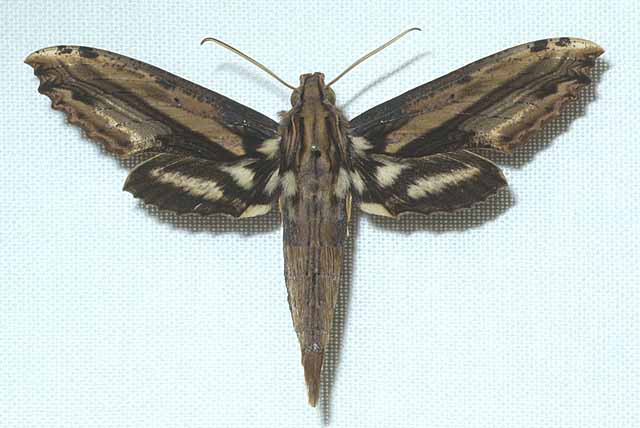
Xylophanes guianensis male courtesy of Hubert Mayer
copyright.
This site has been created by
Bill Oehlke at oehlkew@islandtelecom.com
Comments, suggestions and/or additional information are welcomed by Bill.
TAXONOMY:
Family: Sphingidae, Latreille, 1802
Subfamily: Macroglossinae, Harris, 1839
Tribe: Macroglossini, Harris, 1839
Genus: Xylophanes Hubner [1819] ...........
Species: guianensis Rothschild, 1894
|
MIDI MUSIC
.....It's a Wonderful World.....
copyright C. Odenkirk
ON.OFF
<bgsound src="world.mid" LOOP=FOREVER>
|
DISTRIBUTION: Xylophanes guianensis
(approximate wingspan: males 88mm; females: 105mm)
fly in Guyana (specimen type locality) and
Venezuela and east to
Suriname;
French Guiana: Saint Jean de Maroni; Kaw:
Brazil: Para; south to
Bolivia: Santa Cruz: Ichilo, El Chore.
Xylophanes guianensis moths rest with
wings closed, revealing streamlined head, thorax and abdomen.
| 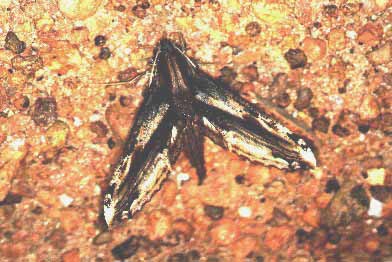 |
The two outer lines run parallel to the median line along the entire
length of the abdomen, whereas in
X. ceratomioides, the outer lines converge towards the
anterior margin of each abdominal segment, giving a chevroned
appearance.
CATE: "Similar overall to Xylophanes ceratomioides. Outer margin of forewing margin much more strongly scalloped than in
Xylophanes ceratomioides.
"Dorsal lines of abdomen as in Xylophanes xylobotes, (not posteriorly divergent and expanded into small, black, triangular patches on each tergite as in
Xylophanes ceratomioides).
"Costa of forewing upperside with several conspicuous subapical and apical black spots, the largest subapical spot quadrate; most distal antemedian line and
most basal postmedian line meet on inner edge of forewing upperside; postmedian lines clearly visible within the postmedian area, almost straight,
except toward inner edge of wing (not scalloped as in Xylophanes ceratomioides); pale brown excavated area on outer margin of postmedian band narrow
(more so than in Xylophanes xylobotes), rectangular and not well defined due to the visible presence within it of the third, fourth and fifth postmedian
lines.
Pale bands of hindwing upperside intermediate in coloration between those of Xylophanes ceratomioides and Xylophanes xylobotes."
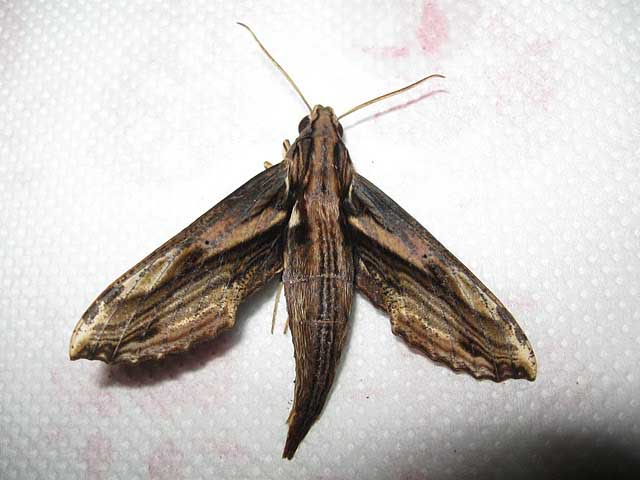
Xylophanes guianensis, Kaw Mountains, French Guiana,
March 31, 2011, courtesy of Andres Urbas.
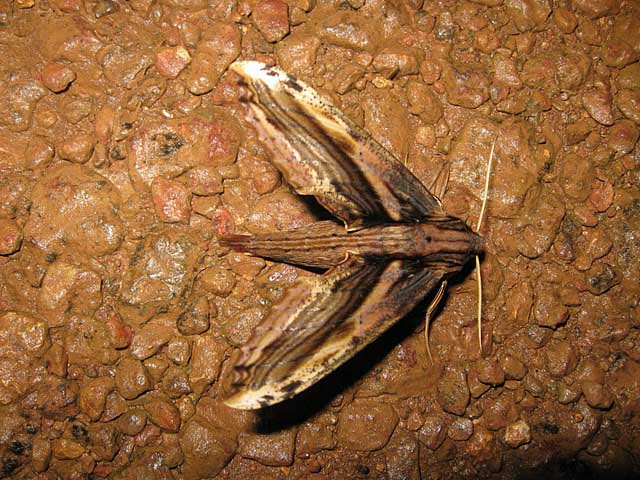
Xylophanes guianensis, Kaw Mountains, French Guiana,
April 6, 2011, courtesy of Andres Urbas.
FLIGHT TIMES:
Xylophanes guianensis adults probably fly
as multiple broods. Andres Urbas reports a March 31, 2011, flight near Kaw Mountains, French Guiana.
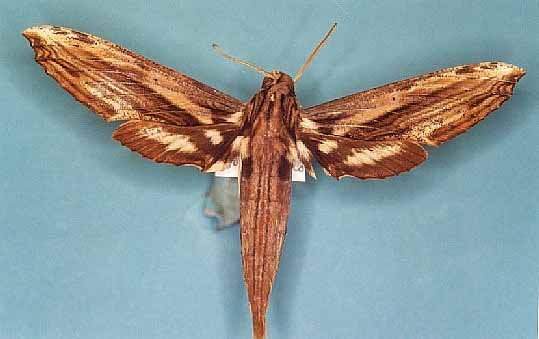
Xylophanes guianensis
ECLOSION:
Pupae probably wiggle to surface from
subterranean chambers just prior to eclosion.
SCENTING AND MATING:Females call in the males with a pheromone released from a gland at the tip of the
abdomen. Males come in to lights very readily, but females are seldom taken in that way.
EGGS, LARVAE, PUPAE:
Larvae probably feed on
Psychotria panamensis and Psychotria nervosa
of the Rubiaceae family and on
Pavonia guanacastensisof the Malvaceae family.
Moths emerge approximately one-two months after larvae pupate.
Use your browser "Back" button to return to the previous page.
Goto Main Sphingidae Index
Goto Macroglossini Tribe
Goto Central American Indices
Goto Carribean Islands
Goto South American Indices
Goto U.S.A. tables

Xylophanes guianensis male, French Guiana, on my home computer only.

Xylophanes guianensis female, French Guiana, on my home computer only.

Xylophanes guianensis, French Guiana, on my home computer only.

Xylophanes guianensis female, French Guiana, November 15, 2009.








